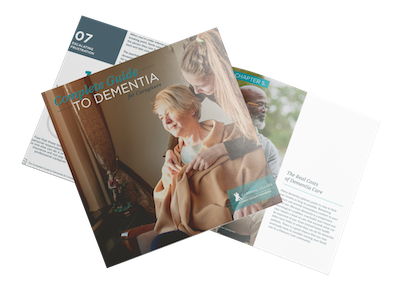During November, health care focus turns to those with cognitive impairments and their caregivers with National Alzheimer’s Disease Awareness Month. President Ronald Reagan started this observance in 1983 to help raise Alzheimer’s awareness. It is also a call to action to get people involved in both the recognition of the condition during Alzheimer Awareness Month, as well as the levels of care that might be required for someone living with Alzheimer’s.
Alzheimer’s is the sixth leading cause of death in the United States, and the third leading cause for older people, according to the National Institute on Aging. A person with Alzheimer’s lives an average of four to eight years after diagnosis, but depending on other factors, these patients can live as long as 20 years.
Learn more about Alzheimer awareness, the disease and other cognitive impairments, symptoms to look out for, and how you can help.
What is Alzheimer’s Disease?
The Alzheimer’s Association defines the disease as a type of dementia that affects memory, thinking and behavior. Alzheimer’s is not the only diagnosis for people with memory impairments, but it is the most common cause of dementia. About 60% to 80% of dementia cases are caused by Alzheimer’s disease.
Memory loss is a common part of aging, but Alzheimer’s is not just linked to age, and is not a normal part of aging. There is no cure for Alzheimer’s, but treatments for symptoms are available and research is ongoing.
What Are Some Other Cognitive Impairments?
Dementia is often divided into two types: cortical and subcortical dementia. This refers to the location where the dementia originates. Cortical dementia is located in the brain’s cerebral cortex, which is involved in memory, language, emotion and other functions. Alzheimer’s disease is a cortical dementia.
Another common condition that can affect people with Alzheimer’s or other dementia is called sundowners syndrome. Seniors with this condition can experience confusion, frustration and agitation that becomes more acute in the evenings. Diminishing evening light can frighten or confuse people with this dementia.
Subcortical dementias, triggered from beneath the brain’s cerebral cortex, usually don’t involve memory or language issues. Those with subcortical dementias can have attention and concentration problems, along with motor function issues.
Find out more about the different types of dementia.

Download the Complete Guide to Dementia for Caregivers
Taking care of a loved one with dementia can be more than challenging. Read our eBook, “The Complete Guide to Dementia for Caregivers” which offers everything you need to know about caring for your loved one.
Download the GuideWhat Are Some Alzheimer’s Disease Symptoms?
Not all age-related memory loss is an indication of Alzheimer’s. Misplacing keys, forgetting names and other everyday annoyances are common. Here’s a look at typical age-related changes and how they relate to signs of Alzheimer’s, according to alz.org.
Typical Age-Related Changes
- Changes in vision, such as those related to cataracts
- Getting confused occasionally about the day of the week
- Making errors now and then when managing finances
- Occasionally need help to complete familiar yet complicated tasks
- Some difficulty finding the right word
- Temporarily forgetting names or appointments
Signs of Alzheimer’s and Dementia
- Challenges in planning or solving problems
- Confusion with dates, seasons and passage of time
- Difficulty completing daily tasks
- Memory loss that disrupts daily life
- New problems with words in speaking or writing, or conversational repetition
- Trouble understanding visual images and spatial relationships
Find out more about Alzheimer’s warning signs, stages and symptoms.
How Can You Help People With Alzheimer’s Disease?
At this time, there is no cure or treatment to slow or stop the progression of Alzheimer’s. Some drugs can be used, however, to temporarily improve symptoms.
Another way to help those with Alzheimer’s and dementia is to control their surroundings to make them more comfortable. Some ways to help include:
- Avoid Overstimulation – Besides controlling the visual and auditory surroundings, keep conversation simple, also. Present patients one idea at a time so they can focus their concentration.
- Be Reassuring – Try to make the patient feel safe and comfortable. Even saying something like “You are safe with me” can be reassuring.
- Don’t Argue or Yell – It is difficult to deal with somebody undergoing dementia, but remember that they are as frustrated as you are – even more. They can no longer grasp what is going on. Be the calming voice they need.
- Keep a Daily Routine – Alzheimer’s patients like routines, which helps avoid confusion. They are more comfortable if they know what to expect.
[Download box]
Download the Complete Guide to Dementia for Caregivers
[The Complete Guide to Dementia for Caregivers Cover]
Caring for a loved one with dementia can be a huge challenge. Our eBook, “The Complete Guide to Dementia for Caregivers” can give you everything you need to know about caring for someone with dementia.
[Download box]
Resources for People With Alzheimer’s and Their Caregivers
There are many sites, organizations and agencies that can help people with Alzheimer’s and those who care for them. Here is a short list to help you tread the unpredictable path of aging and memory loss..
- AARP – This nonpartisan, nonprofit organization offers information and services to aging people. AARP has information on care options, offers legal checklists, hosts an online community, and has a page of local resources and links to medical services, Alzheimer’s programs and more. A Family Caregiving guide is also available.
- Alzheimer’s Association – This group provides resources for those with Alzheimer’s and dementia, along with their caregivers. Included is information on symptoms, diagnosis, stages, treatment, care and support resources. An online tools page offers ALZConnected online community, a planning aid called Alzheimer’s Navigator, e-learning workshops and more.
- Alzheimer’s Foundation of America – This group has resources for those with Alzheimer’s and dementia, and for their caregivers. Included on the site are Caregiving Resources with a free helpline, free community classes, dozens of fact sheets, webinars and more. The AFA also offers a National Memory Screening Program.
- Alzheimers.gov – This federal government site provides free information about Alzheimer’s disease, Medicare coverage, treatment options and referrals to local resources.
- Centers for Medicare & Medicaid Services – This government site offers patients and their caregivers connections with Medicare and Medicaid information, resources, forms and more.
- Family Caregiver Alliance – This site from the National Center on Caregiving has resources for caregivers. The Dementia Caregiver Resources section offers caregiver stories, guides and tips sheets.
- National Alliance for Caregiving – In this group’s Brain Health Conversation Guide, readers will find helpful advice for having difficult discussions about cognitive health and memory changes.
- Senior Lifestyle: The Complete Guide to Dementia for Caregivers – This guide from Senior Lifestyle provides tips and hints for those caring for a loved one with dementia or Alzheimer’s.

